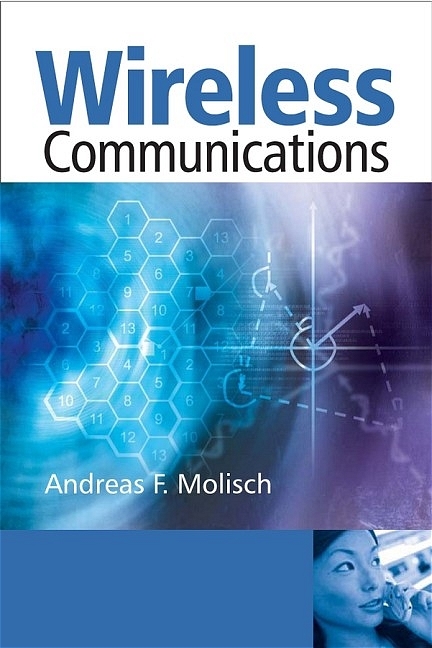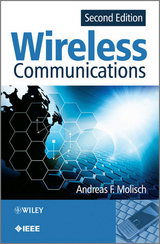
Wireless Communications
Wiley-Blackwell (Verlag)
978-0-470-84887-6 (ISBN)
- Titel erscheint in neuer Auflage
- Artikel merken
"Wireless Communications" presents the most comprehensive coverage of this field which, in only a decade, has grown from a niche market into one of the most important industries. While previous systems were generally intended to provide mobile speech communications, mobile data communications have since developed. This essential textbook on the principles and applications of mobile radio is an all-encompassing current treatment of the area, addressing both the traditional elements, such as Rayleigh fading, BER in flat fading channels, and equalization, and more recently emerging topics like multi-user detection in CDMA systems, OFDM and smart antennas. These fundamentals are related to practical systems, and the dominant wireless standards, including cellular, cordless and wireless LANs, are discussed. It offers a comprehensive and current treatment of a very hot topic, one of the fastest growing fields of communications. Topics featured include: wireless propagation channels, transceivers and signal processing, multiple access and advanced transceiver schemes, and standardized wireless systems.
The book combines mathematical descriptions with intuitive explanations of the physical facts, to assist readers in acquiring a deeper understanding of the area. "Wireless Communications" is an essential text for advanced undergraduate students with a working knowledge of standard digital communications, graduate students and practising engineers. It will also be an invaluable source of reference for wireless communications engineers. The companion website includes: supplementary material on 'DECT' Solutions manual and presentation slides for instructors; appendices; list of abbreviations; and, other useful resources.
Preface. List of abbreviations. List of symbols. PART I: INTRODUCTION. 1 Applications and requirements of wireless services. 1.1 History. 1.2 Types of services. 1.3 Requirements for the services. 1.4 Economic and social aspects. 2 Technical challenges of wireless communications. 2.1 Multipath propagation. 2.2 Spectrum limitations. 2.3 Limited energy. 2.4 User mobility. 3 Noise- and interference-limited systems. 3.1 Introduction. 3.2 Noise-limited systems. 3.3 Interference-limited systems. PART II: WIRELESS PROPAGATION CHANNELS. 4 Propagation mechanisms. 4.1 Free space loss. 4.2 Reflection and transmission. 4.3 Diffraction. 4.4 Scattering by rough surfaces. 4.5 Waveguiding. 5 Statistical description of the wireless channel. 5.1 Introduction. 5.2 The time-invariant two-path model. 5.3 The time-variant two-path model. 5.4 Small-scale fading without a dominant component. 5.5 Small-scale fading with a dominant component. 5.6 Doppler spectra. 5.7 Temporal dependence of fading. 5.8 Large-scale fading. 6 Wideband and directional channel characterization. 6.1 Introduction. 6.2 The causes of delay dispersion. 6.3 System-theoretic description of wireless channels. 6.4 The WSSUS model. 6.5 Condensed parameters. 6.6 Ultrawideband channels. 6.7 Directional description. 7 Channel models. 7.1 Introduction. 7.2 Narrowband models. 7.3 Wideband models. 7.4 Directional models. 7.5 Deterministic channel-modeling methods. 8 Channel sounding. 8.1 Introduction. 8.2 Time domain measurements. 8.3 Frequency domain analysis. 8.4 Modified measurement methods. 8.5 Directionally resolved measurements. 9 Antennas. 9.1 Introduction. 9.2 Antennas for mobile stations. 9.3 Antennas for base stations. PART III: TRANSCEIVERS ANDSIGNAL PROCESSING. 10 Structure of a wireless communication link. 10.1 Transceiver block structure. 10.2 Simplified models. 11 Modulation formats. 11.1 Introduction. 11.2 Basics. 11.3 Important modulation formats. 12 Demodulation. 12.1 Demodulator structure and error probability in additive-white-Gaussian-noise channels. 12.2 Error probability in flat-fading channels. 12.3 Error probability in delay- and frequency-dispersive fading channels. 13 Diversity. 13.1 Introduction. 13.2 Microdiversity. 13.3 Macrodiversity and simulcast. 13.4 Combination of signals. 13.5 Error probability in fading channels with diversity reception. 13.6 Transmit diversity. 14 Channel coding. 14.1 Introduction. 14.2 Block codes. 14.3 Convolutional codes. 14.4 Trellis-coded modulation. 14.5 Turbocodes. 14.6 Low-density parity check codes. 14.7 Coding for the fading channel. 15 Speech coding (Gernot Kubin, Graz University of Technology, Austria). 15.1 Introduction. 15.2 The sound of speech. 15.3 Stochastic models for speech. 15.4 Quantization and coding. 15.5 From speech transmission to acoustic telepresence. 16 Equalizers. 16.1 Introduction. 16.2 Linear equalizers. 16.3 Decision feedback equalizers. 16.4 Maximum-likelihood sequence estimation - Viterbi detector. 16.5 Comparison of equalizer structures. 16.6 Fractionally spaced equalizers. 16.7 Blind equalizers. PART IV: MULTIPLE ACCESS ANDAD VANCED TRANSCEIVER SCHEMES. 17 Multiple access and the cellular principle. 17.1 Introduction. 17.2 Frequency division multiple access. 17.3 Time division multiple access. 17.4 Packet radio. 17.5 Duplexing. 17.6 Principles of cellular networks. 18 Spread spectrum systems. 18.1 Frequency-hopped multiple access. 18.2 Code division multiple access. 18.3 Cellular code-division-multiple-access systems. 18.4 Multiuser detection. 18.5 Time-hopping impulse radio. 19 Orthogonal frequency division multiplexing (OFDM). 19.1 Introduction. 19.2 Principle of orthogonal frequency division multiplexing. 19.3 Implementation of transceivers. 19.4 Frequency-selective channels. 19.5 Channel estimation. 19.6 Peak-to-average power ratio. 19.7 Intercarrier interference. 19.8 Adaptive modulation and capacity. 19.9 Multiple access. 19.10 Multicarrier code division multiple access. 19.11 Single-carrier modulation with frequency-domain equalization. 20 Multiantenna systems. 20.1 Smart antennas. 20.2 Multiple-input multiple-output systems. PART V: STANDARDIZED WIRELESS SYSTEMS. 21 GSM - Global System for Mobile communications. 21.1 Historical overview. 21.2 System overview. 21.3 The air interface. 21.4 Logical and physical channels. 21.5 Synchronization. 21.6 Coding. 21.7 Equalizer. 21.8 Circuit-switched data transmission. 21.9 Establishing a connection and handover. 21.10 Services and billing. 22 IS-95 and CDMA 2000. 22.1 Historical overview. 22.2 System overview. 22.3 Air interface. 22.4 Coding. 22.5 Spreading and modulation. 22.6 Logical and physical channels. 22.7 Handover. 23 WCDMA/UMTS. 23.1 Historical overview. 23.2 System overview. 23.3 Air interface. 23.4 Physical and logical channels. 23.5 Speech coding, multiplexing, and channel coding. 23.6 Spreading and modulation. 23.7 Physical-layer procedures. 24 Wireless Local Area Networks. 24.1 Introduction. 24.2 802.11a - Orthogonal-frequency-division-multiplexing-based local area networks. 24.3 802.11b - Wireless Fidelity. 24.4 Packet transmission in 802.11 wireless local area networks. 24.5 Alternative wireless local area networks and future developments. 25 Exercises (Peter Almers, Ove Edfors, Fredrik Floren, Anders Johanson, Johan Karedal, Buon Kiong Lau, Andreas F. Molisch, Andre Stranne, Fredrik Tufvesson, and Shurjeel Wyne). 25.1 Chapter 1: Applications and requirements of wireless services. 25.2 Chapter 2: Technical challenges of wireless communications. 25.3 Chapter 3: Noise- and interference-limited systems. 25.4 Chapter 4: Propagation mechanisms. 25.5 Chapter 5: Statistical description of the wireless channel. 25.6 Chapter 6: Wideband and directional channel characterization. 25.7 Chapter 7: Channel models. 25.8 Chapter 8: Channel sounding. 25.9 Chapter 9: Antennas. 25.10 Chapter 10: Structure of a wireless communication link. 25.11 Chapter 11: Modulation formats. 25.12 Chapter 12: Demodulation. 25.13 Chapter 13: Diversity. 25.14 Chapter 14: Channel coding. 25.15 Chapter 15: Speech coding. 25.16 Chapter 16: Equalizers. 25.17 Chapter 17: Multiple access and the cellular principle. 25.18 Chapter 18: Spread spectrum systems. 25.19 Chapter 19: Orthogonal frequency division multiplexing (OFDM). 25.20 Chapter 20: Multiantenna systems. 25.21 Chapter 21: GSM - Global System for Mobile communications. 25.22 Chapter 22: IS-95 and CDMA 2000. 25.23 Chapter 23: WCDMA/UMTS. 25.24 Chapter 24: Wireless Local Area Networks. References. Index.
| Erscheint lt. Verlag | 18.11.2005 |
|---|---|
| Reihe/Serie | Wiley - IEEE |
| Zusatzinfo | illustrations |
| Verlagsort | Hoboken |
| Sprache | englisch |
| Maße | 180 x 248 mm |
| Gewicht | 1292 g |
| Einbandart | gebunden |
| Themenwelt | Technik ► Elektrotechnik / Energietechnik |
| ISBN-10 | 0-470-84887-1 / 0470848871 |
| ISBN-13 | 978-0-470-84887-6 / 9780470848876 |
| Zustand | Neuware |
| Informationen gemäß Produktsicherheitsverordnung (GPSR) | |
| Haben Sie eine Frage zum Produkt? |
aus dem Bereich



